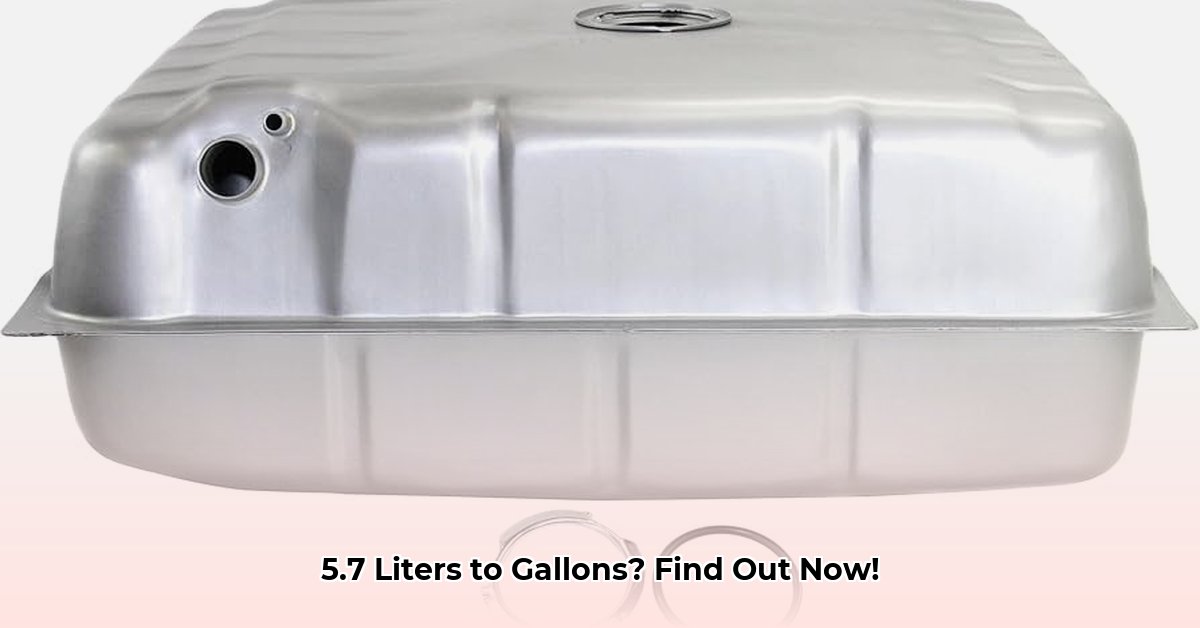
Understanding the Gallon Conundrum: Why Simple Conversions Aren't So Simple
Converting liters to gallons seems straightforward, but a crucial detail often gets overlooked: there isn't just one type of gallon. The existence of US liquid gallons, US dry gallons, and Imperial gallons significantly impacts the conversion outcome. This guide provides a clear, step-by-step process to accurately convert 5.7 liters to each type of gallon, ensuring precise results for various applications. For further unit conversions, check out this helpful currency converter.
Did you know that the difference between these gallon types can lead to significant errors in various fields such as construction, cooking, or fuel efficiency calculations?
The Great Gallon Divide: Three Types, Three Conversions
Three distinct gallon types exist, each with a unique volume:
US Liquid Gallon: Primarily used for measuring liquid volumes in the United States (e.g., gasoline, milk). One US liquid gallon is approximately 3.785 liters.
US Dry Gallon: Used for measuring dry goods in the United States (e.g., grain, flour). This is noticeably larger than the US liquid gallon, containing approximately 4.405 liters.
Imperial Gallon: Used predominantly in the United Kingdom and several Commonwealth countries. It's the largest of the three, holding approximately 4.546 liters.
Here's a table summarizing the differences:
| Gallon Type | Liters per Gallon (approx.) |
|---|---|
| US Liquid Gallon | 3.785 |
| US Dry Gallon | 4.405 |
| Imperial Gallon | 4.546 |
This variation highlights the critical need to specify the gallon type for accurate conversions. Failing to do so can lead to substantial inaccuracies.
Converting 5.7 Liters: A Precise Approach
Let's convert 5.7 liters to each gallon type using the following formula:
Gallons = Liters ÷ Liters per Gallon
1. US Liquid Gallons:
- Calculation: 5.7 liters / 3.785 liters/gallon ≈ 1.51 gallons
2. US Dry Gallons:
- Calculation: 5.7 liters / 4.405 liters/gallon ≈ 1.29 gallons
3. Imperial Gallons:
- Calculation: 5.7 liters / 4.546 liters/gallon ≈ 1.25 gallons
Notice the substantial differences in the results. The precise conversion depends entirely on the type of gallon used. This emphasizes the importance of clarifying the units of measurement.
Practical Applications: Where Precision Matters
Understanding these differences isn't just a matter of academic interest. Accurate conversion is essential in various real-world scenarios:
Fuel Efficiency: Calculating fuel consumption involves careful consideration of the units used (liters vs. gallons), especially in comparing data from different sources.
Cooking and Baking: Recipes from different regions might utilize different gallon types. Inaccurate conversion can significantly affect the final result.
International Trade: Miscommunication regarding gallon types can have costly consequences in international business transactions involving liquids or dry goods. Clarity is paramount.
Construction and Engineering: Accurate measurements are critical in various projects, particularly those involving volume calculations.
Utilizing Online Tools and Avoiding Common Pitfalls
Numerous online converters are available, simplifying the conversion process. However, remember to always double-check the gallon type selected before executing the conversion. The most common pitfall is neglecting to specify the gallon type, leading to inaccurate results.
Conclusion: The Importance of Precision and Clarity
Converting 5.7 liters to gallons requires careful attention to detail. Understanding the differences between US liquid, US dry, and Imperial gallons is critical for achieving accurate and reliable results. Always clarify the type of gallon being used to avoid costly errors or inconsistencies. Using online calculators can aid in the process, but specifying the correct gallon type remains the user's responsibility. This process underscores the vital importance of precise and clear communication when working with different measurement systems.